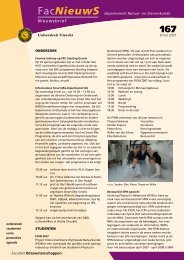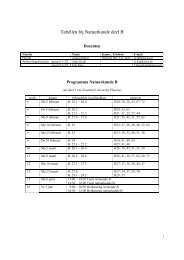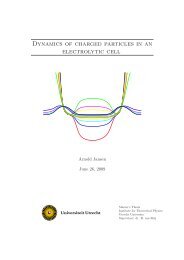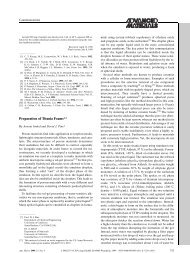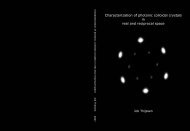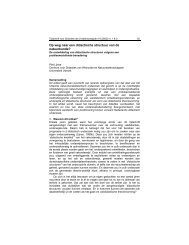Sedimentation Equilibrium of Mixtures of Charged Colloids
Sedimentation Equilibrium of Mixtures of Charged Colloids
Sedimentation Equilibrium of Mixtures of Charged Colloids
Create successful ePaper yourself
Turn your PDF publications into a flip-book with our unique Google optimized e-Paper software.
Chapter 7Conclusions and OutlookWithin the framework <strong>of</strong> density functional theory we derived a Poisson-Boltzmann theory to describe the equilibrium <strong>of</strong> diluted systems <strong>of</strong> chargedcolloids under sedimentation. The numerical solutions for monodisperse(n=1) cases show strong deviations from the barometric distribution in thelow salt limit, as was already shown in experiments [11]. For binary (n=2)and ternary (n=3) systems the solutions show segregation <strong>of</strong> components aswell. The salt entropy is seen to be the driving mechanism behind theseeffects. The colloids are lifted by an electric field that cancels gravity. Sincecomponents <strong>of</strong> different mass per charge cannot be lifted by the same electricfield, the components order according to their mass per charge and formlayers. Although the ordering still lacks experimental confirmation, the numericalsolutions agree very well with Monte Carlo simulations [15, 22]. Forpolydisperse systems (n=10,n=21), the same effects are predicted by the theory,although the segregation is in many cases weaker than in the binary andternary examples.An extension <strong>of</strong> the theory to charge regulating systems can be made byconsidering the colloidal charge to be dependent on the electrostatic potential,according to the Langmuir isotherm. The numerical results from thisextension do not show the linear density pr<strong>of</strong>iles, and constant electric fieldsas calculated from the theory describing charge stabilised colloids. Althoughthe solutions show the same phenomena, the pr<strong>of</strong>iles decrease more stronglywith height. This can be understood by comparing monodisperse systems<strong>of</strong> charge regulating colloids with polydisperse systems <strong>of</strong> charge stabilisedcolloids.The exact dependence <strong>of</strong> the charge still lacks a proper derivation, and thenumerical calculations are not confirmed by simulation data or experiments,making the extension less underpinned than the PB theory for charge stabilisedsystems.51



